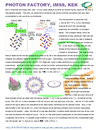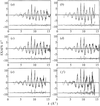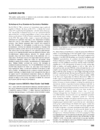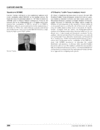issue contents
May 2004 issue

Cover illustration: False-colour CCD image taken in the focal plane of two crossed prism lenses, of the type shown at the bottom left, see Jark, Pérennès, Matteucci, Mancini, Montanari, Rigon, Tromba, Somogyi, Tucoulou and Bohic, pages 248-253. These lenses were produced at the deep X-ray lithography beamline of ELETTRA, and the CCD image was taken at the SYRMEP beamline at ELETTRA. The vertically and horizontally focusing lenses and their supports are seen as blue shadows in the yellow beam. The saturated white spot is the focus, in which an intensity gain of 25 is obtained (see the vertical and horizontal beam profiles).
facility information
research papers
A study of the potential for the development of the Linac Coherent Light Source beyond the specifications of the baseline design is presented.
Beamline 10.3.2 at the ALS is a hard X-ray microprobe beamline specialized for environmental and materials studies. It produces a 5–17 µm spot with an energy range of 3–17 keV, with which X-ray fluorescence mapping, µEXAFS and µXRD can be performed on the same sample at the same position.
A new X-ray lens composed of two large prisms, each composed of a highly regular structure of smaller prism-like segments, is reported. Prototype lenses produced by deep X-ray lithography with apertures larger than 2 mm focused X-ray beams with 8 keV photon energy in one dimension to a line with a width in the micrometer range.
Open  access
access
 access
accessStructural and magnetic characterization of a magnetically modulated 5 nm Ni layer in a Cu/Ni/Cu system using specular reflection and rocking scans in X-ray resonant scattering with polarized soft X-rays.
Schemes are given to influence the time response of a crystal reflection to short incident X-ray pulses.
Using resonant scattering of the GaAs 200 reflection, not only lattice defects but also lattice distortions around a dislocation were selectively observed in topographic images.
The application of grazing-incidence small-angle scattering techniques to ion-implanted materials is presented. Methods for the optimization of the data collection and data analysis are described, showing an example on Au + Cu-implanted silica glasses.
The possibility of extracting structural information from EXAFS data taken in the fluorescence mode using an energy-resolving detector at very high count rates has been studied. Reliable methods which are able to correct the systematic errors introduced by pulse pile-up are proposed.
X-ray absorption spectroscopic studies on gold nanoparticles in mesoporous and microporous materials
A series of gold nanoparticles within different mesoporous and microporous materials have been investigated using X-ray absorption fine structure and other techniques.
EXAFS oscillations of MoO3 have been calculated using backscattering amplitudes and phase shifts derived from the FEFF8 code and using Debye–Waller factors from an equation-of-motion method. Comparisons were made with polarization-dependent empirical EXAFS data of the α-MoO3 single crystal at various temperatures.
computer programs
A computer program designed for least-squares fitting of bulk XAFS spectra to end-member components and for performing significance tests is described.
current events
Free 

Free 

Free 

Free 



 journal menu
journal menu







































